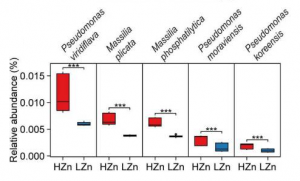A group from Chinese Academy of Agricultural Sciences, Shenzhen, China, etc. has reported that high Zn wheat recruit more bacteria relevant to Zn mobilization in the rhizosphere.
https://www.ncbi.nlm.nih.gov/pmc/articles/PMC8261137/
Around 20% of the world population are suffering from zinc (Zn) deficiency, and the situation will become worse with the increase of atmosphere carbon dioxide. An effective solution to address human Zn deficiency is to increase the grain Zn concentration of staple food crops like wheat, namely, Zn biofortification. The target of wheat Zn biofortification is to increase the current grain Zn concentration of 20 ~ 30 mg/kg to above 40 mg/kg that is sufficient for human Zn nutrition.
Due to the poor mobility of Zn in soil, the absorption of Zn by plant roots mainly occurs in the rhizosphere, where the activities of roots and microorganisms can somewhat increase the amount of available Zn. In the calcareous soils distributed worldwide, Zn availability is restricted by alkaline environment and high carbonate content; and various root exudates like carboxylic acids, amino acids, and low-molecular-weight polypeptides can acidify the rhizosphere and solubilize the Zn immobilized in minerals. Besides, the microbes living on root exudates can also produce organic acids, siderophores, and exopolysaccharides that can mobilize micronutrients in rhizosphere soil.
Comparisons of the relative abundances of rhizosphere-enriched species between High Zn (HZn) and Low Zn (LZn) wheat found that 30 species were significantly enriched in HZn with the abundance ratio of HZn to LZn >1.5 and two species were enriched in LZn with the abundance ratio of HZn to LZn <0.5. Of the 32 species, three HZn-enriched species belong to the reported soil Zn-mobilizing genus Pseudomonas, which is one of the 38 previously published Zn-mobilizing microbial species or genera. Nearly half of the previously reported Zn-mobilizing microbes were enriched in wheat rhizosphere, but most of them showed no significant difference between HZn and LZn. Differently, the 32 HZn- or LZn-enriched species were also enriched in wheat rhizosphere, and they exhibited significant differences between HZn and LZn, such as much higher abundances of Pseudomonas and Massilia species in HZn than those in LZn. Besides, genome functional annotation of the 32 species showed that 28 HZn-enriched and two LZn-enriched species possess the functional genes involved in soil Zn mobilization. Therefore, the previously reported Zn-mobilizing microbes can promote the Zn uptake of all wheat plants, while the identified 30 HZn- or LZn-enriched species may be the potential soil Zn-mobilizing microbes contributing to the variations of shoot Zn uptake and grain Zn concentration among cultivars.
It would be true that the HZn wheat recruit more bacteria relevant to soil Zn mobilization in the rhizosphere, suggesting that the difference between Hzn wheat and LZn wheat cultivars comes from the difference in microbiome of the rhizosphere. However, how HZn wheat recruit Zn mobilization bacteria is still unknown.

